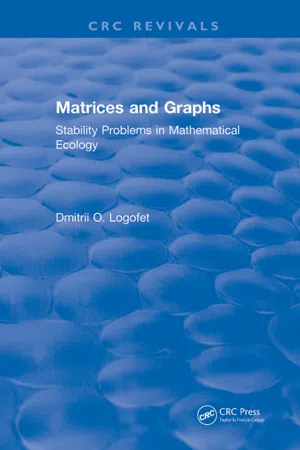In spite of appearing to be intuitively clear, “an ability to persist in spite of perturbations” can scarcely be defined in a unique and unambiguous way. The reason for this difficulty is that both the “persistence” and the “perturbations” parts of the idea need further clarification, to say nothing of the scale factors of the system being considered. What is understood by “an ability to persist” and what kind of “perturbations” is relevant? Different answers to these basic questions and a variety of stability concepts have been proposed and discussed in the ecological literature,1 and 2 (yet only a few of them have been given proper mathematical attention3 and 4). Perhaps this is why stability in general lacks—and should apparently not have—any “stable” definition.
A. Species Diversity as a Measure of Stability
It has long been a paradigm of theoretical ecology that the more complex the structure of a biological community is and the more abundant the number of constituent species in it, the more stable the community will be in response to perturbations.5 and 6 The argument in favor of this thesis—first proposed apparently by MacArfhur7 and Elton8—is briefly as follows. Various species have different ranges of adaptation to changes in their environment. A wider species composition may therefore respond to various environmental changes more successfully than a community with a lower number of species. The former is hence considered to be more stable than the latter. This is probably the main reason why a variety of species diversity indices (in particular, the entropy of information theory or its analogs) are used to characterize the community’s stability.6
The most popular index is the Shannon information entropy measure:
where n is the number of species in a community, Ni is the population size of the ith species. A somewhat different measure, but of the same genus, is the index
It can be shown that D1 represents the probability that two individuals, when chosen randomly from a set of N ones, do not belong to the same species. For large values of N and uniform enough distribution of N among species, the proportion of species i can be assumed to approximate pi ≈ 1 + In pi, whereby it can be shown that D1 ≈ D.
Other definitions of this kind (e.g., those using R. A. Fisher’s measure of information) have also been proposed as stability measures, yet all of them rely upon notions originating from theoretical physics or information theory (see a survey by Goodman6). There is no doubt that diversity measures do carry some objective information about the properties of a system. E. Odum9 has shown, for instance, that there are certain relationships among the diversity level, the structure, and the functioning of energy flows in an ecosystem. However, using such diversity indices as stability measures leads to some drawbacks, or paradoxes, in the theory,10,4 where a typical “route” to a drawback can be traced in the following argument.
Under the “maximum diversity-maximum stability” assumption, it would be logical to suppose further that maximum stability is attained at equilibrium, if this state is ever reached. A simple exercise in finding a conditional maximum of a function like D(p) over the space of frequencies pi will then readily generate a fixed pattern of equilibrium distribution, which can hardly be interpreted in ecological terms. For example, the maximum of D (1.1) is attained at p* = [1/n, 1/n,..., 1/n], i.e., at uniform species abundance. This excludes any species domination or quantitative hierarchy in the community, whereas the empirical evidence is just the opposite: communities which exist long enough to be considered stable do feature dominating species, which carry out the major part of the work to provide for the matter and energy turnover through the ecosystem.11 In other words, a quantitative hierarchy, rather than uniformity, is normal for a real system.
Other diversity indices may, of course, generate hierarchical distributions too, but the causes of the hierarchy will always be fixed to a particular mathematical form of the diversity function to be maximized, rather than to real properties of the system under study. That is why the use of diversity indices as measures of stability can scarcely be accepted as a faultless approach.
On the other hand, an increase in diversity may really be observed in many natural and laboratory communities, particularly at the early stages of their evolution to an equilibrium state. To all appearances, the diversity measures are still able to characterize a community in some dynamic respects, although falling short of general applicability.
The reason for such paradoxes probably arise because the models of theoretical physics and information theory are formally applied to systems to which they are not applicable. Both the Boltzmann entropy in statistical physics and the information entropy in information theory make sense only for ensembles of weak interactions among particles or other objects. Introducing an entropy measure is grounded quite well for such ensembles. But once we turn to systems whose elements interact strongly, the entropy measure can no longer suffice. Biological communities and ecosystems represent systems with strong interactions, because it is mainly the interactions themselves among constituent species or ecosystem components that form the structure of the system.
As far as a steady equilibrium can be regarded as the final outcome of the functioning of structure, quite explainable may be progress in the application of entropy measures at early stages of community evolution. The point is that, these stages being far from equilibrium, the competition or other interactions among species are still we...


